| Ruokolahti Church | |
|---|---|
Ruokolahden kirkko | |
 Ruokolahti Church in 2012 | |
 | |
| 61°17′04″N 28°49′47″E / 61.28444°N 28.82986°E | |
| Location | Ruokolahti |
| Country | Finland |
| Denomination | Lutheran |
| Website | ruokolahdenseurakunta |
| History | |
| Status | Parish church |
| Architecture | |
| Functional status | Active |
| Heritage designation | Protected |
| Architect(s) | Ernst Lohrmann |
| Style | Neogothic (partly)[1] |
| Completed | 1854 |
| Specifications | |
| Capacity | c. 1,200[1] |
| Number of spires | 1 |
| Materials | Timber |
| Administration | |
| Parish | Ruokolahti parish (Ruokolahden seurakunta) |
Ruokolahti Church (Finnish: Ruokolahden kirkko, Swedish: Ruokolax kyrka) is the Lutheran church in the town centre of Ruokolahti, in south-eastern Finland, and the main church of the Ruokolahti parish.
The church was designed in 1852 by a leading architect of the mid-19th century in Finland, Ernst Lohrmann, constructed of timber, and completed in 1854.[1][2] The belfry predates the current church by 100 years, having been built in 1752 for the previous church in the same spot.[1] The church and belfry have been designated and protected by the Finnish Heritage Agency as a nationally important built cultural environment (Valtakunnallisesti merkittävä rakennettu kulttuuriympäristö).[2]
The current altarpiece is a 1915 painting by Alexandra Frosterus-Såltin, titled Kristus ristillä ('Christ on the cross'). It is her 50th and final altarpiece.[1]
Ruokolahti Church is featured in a famous 1887 painting by Albert Edelfelt, Ruokolahden eukkoja kirkonmäellä (lit. 'Women outside the Church at Ruokolahti'), housed in the Ateneum art museum of the Finnish National Gallery in Helsinki.[3]
Finnish veteran Simo Häyhä, known better by his epithet the "White death" is buried in the graveyard.
- ^ a b c d e "Church Hill". Ruokolahti.fi. Ruokolahti Municipality. Retrieved 30 December 2020.
- ^ a b "Kohdetiedot - Ruokolahden kirkko ja kellotapuli". RKY.fi (in Finnish). Finnish Heritage Agency. Retrieved 30 December 2020.
- ^ "Women Outside the Church at Ruokolahti". Kansallisgalleria.fi. Finnish National Gallery. Retrieved 30 December 2020.


